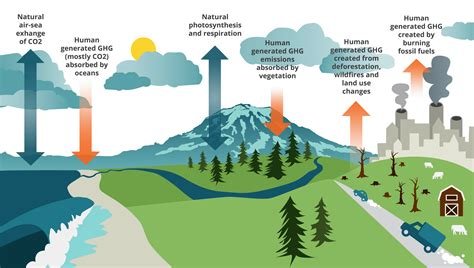The Science of Climate Change: Understanding Environmental Impact and Solutions
Climate change is a complex and pressing issue that affects every aspect of our planet, from the air we breathe to the biodiversity of our ecosystems. Understanding the science behind climate change is crucial in order to comprehend its environmental impact and work towards sustainable solutions. In this blog post, we will delve into the various facets of climate change, from the role of greenhouse gases and the impact of deforestation to the effects of melting polar ice caps and the relationship between rising temperatures and extreme weather events. We will also explore the crucial role of human activities in driving climate change and the importance of renewable energy sources in combating it. Additionally, we will discuss technological advancements for reducing carbon emissions, the implications of climate change on biodiversity, and mitigation strategies for minimizing its environmental impact. Finally, we will examine the role of international agreements in addressing climate change on a global scale. Join us as we unravel the science of climate change and delve into the solutions that can help mitigate its impact on our planet.
Role of greenhouse gases in climate change
Greenhouse gases, such as carbon dioxide, methane, and nitrous oxide, play a significant role in contributing to climate change. These gases act like a blanket, trapping heat in the Earth’s atmosphere and causing the planet to warm. As a result, the Earth’s climate is being altered, leading to a range of environmental impacts.
The emissions of these greenhouse gases are primarily the result of human activities such as the burning of fossil fuels, deforestation, and industrial processes. This has led to an increase in the concentration of these gases in the atmosphere, leading to a phenomenon known as the greenhouse effect.
As the concentration of greenhouse gases in the atmosphere continues to rise, the Earth’s climate is projected to change at an unprecedented rate, leading to a variety of consequences such as rising sea levels, extreme weather events, and disruptions to ecosystems.
Therefore, it is crucial to understand the role of greenhouse gases in climate change and take steps to reduce their emissions in order to mitigate the impacts of climate change on our planet.
Impact of deforestation on global warming
Deforestation, the clearing of large areas of forests, has a significant impact on global warming. Forests play a crucial role in regulating the carbon cycle and mitigating the effects of climate change. When forests are cleared, the stored carbon is released into the atmosphere, contributing to the increase in greenhouse gases such as carbon dioxide. This process significantly exacerbates global warming and further disrupts the delicate balance of the Earth’s climate system.
Moreover, deforestation also diminishes the Earth’s capacity to absorb carbon dioxide from the atmosphere. Trees and other vegetation act as natural carbon sinks, capturing and storing carbon dioxide during the process of photosynthesis. As forests are cleared, the loss of these vital carbon sinks leads to an increase in atmospheric carbon dioxide levels, further intensifying the greenhouse effect and global warming.
In addition, deforestation also affects regional weather patterns, leading to changes in temperature and precipitation that can exacerbate the effects of global warming. By disrupting the natural habitats and ecosystems of various plant and animal species, deforestation also contributes to the loss of biodiversity, which can have far-reaching ecological and environmental consequences.
Addressing the impact of deforestation on global warming is crucial for mitigating the effects of climate change and preserving the Earth’s natural balance. Implementing effective forest conservation and sustainable forest management practices, as well as promoting reforestation efforts, are essential steps in reducing the contribution of deforestation to global warming and achieving a more sustainable and resilient planet.
Effects of melting polar ice caps on sea levels
When discussing the effects of melting polar ice caps on sea levels, it’s important to consider the potential impact on coastal communities and ecosystems. As the polar ice caps melt, the resulting influx of freshwater into the oceans can lead to a rise in sea levels. This can have serious consequences for low-lying areas, increasing the risk of flooding and erosion.
Furthermore, the rise in sea levels can also lead to the loss of coastal habitats and the displacement of people living in these areas. This can result in the loss of important ecosystems and the disruption of communities that rely on coastal resources for their livelihoods.
In addition to the direct impact on coastal areas, the rise in sea levels can also lead to saltwater intrusion into freshwater sources, affecting agriculture and drinking water supplies. This can have far-reaching consequences for both human and natural communities, further exacerbating the impacts of melting polar ice caps on sea levels.
Overall, the effects of melting polar ice caps on sea levels are a significant concern for both human and natural systems, highlighting the urgent need for global action to address climate change and its associated impacts.
Relationship between rising temperatures and extreme weather events
As global temperatures continue to rise due to climate change, the frequency and intensity of extreme weather events are also on the rise. Higher temperatures can lead to more frequent and severe heatwaves, droughts, and intense storms, all of which have significant impacts on both human populations and the environment.
One of the key relationships between rising temperatures and extreme weather events is the increased likelihood of heatwaves. As temperatures climb, so too does the frequency and duration of heatwaves, which can have serious consequences for human health, especially in vulnerable populations.
In addition to heatwaves, rising temperatures also contribute to the intensification of storms, such as hurricanes and typhoons. Warmer ocean temperatures can fuel these storms, leading to more powerful winds, heavier rainfall, and higher storm surges, all of which can cause widespread destruction and loss of life.
Furthermore, the relationship between rising temperatures and extreme weather events also extends to changes in precipitation patterns, which can result in prolonged droughts in some regions and more intense rainfall in others. These shifts in precipitation can lead to water scarcity, increased risk of flooding, and disruption of ecosystems.
The role of human activities in climate change
Human activities have played a significant role in contributing to the ongoing issue of climate change.
Greenhouse gas emissions resulting from the burning of fossil fuels for energy, transportation, and industrial processes have led to an increase in global temperatures. The release of carbon dioxide, methane, and nitrous oxide into the atmosphere has intensified the greenhouse effect, trapping heat and causing the Earth’s average temperature to rise.
Furthermore, deforestation and land-use changes for agriculture and urbanization have contributed to the imbalance of carbon cycle, resulting in higher levels of carbon dioxide in the atmosphere. These human-induced activities have accelerated the process of global warming and its associated impacts on the environment and ecosystems.
It is crucial for individuals, communities, and governments to recognize the significant role of human activities in climate change and take proactive measures to reduce carbon emissions, promote sustainable practices, and invest in renewable energy sources to mitigate the impact of climate change on the planet.
Importance of renewable energy sources in combating climate change
Renewable energy sources, such as solar, wind, hydro, and geothermal power, play a crucial role in combating climate change. These clean energy sources produce minimal greenhouse gas emissions, which helps reduce the overall carbon footprint. By shifting away from traditional fossil fuels, renewable energy sources contribute to a more sustainable and environmentally-friendly energy infrastructure.
Investing in renewable energy technologies can also lead to job creation, economic growth, and enhanced energy security. By developing and utilizing renewable energy sources, countries can reduce their dependence on imported fossil fuels, thereby increasing their energy independence and resilience to global energy market fluctuations.
Furthermore, transitioning towards renewable energy sources can help mitigate the impacts of climate change by decreasing air and water pollution, preserving natural landscapes, and protecting wildlife habitats. By embracing a sustainable energy future, societies can work towards a healthier planet for current and future generations.
In conclusion, the importance of renewable energy sources in combating climate change cannot be overstated. Embracing clean and sustainable energy options is essential for reducing greenhouse gas emissions, promoting economic development, and safeguarding the environment for the long term.
Technological advancements for reducing carbon emissions
Technological advancements play a crucial role in the global efforts to reduce carbon emissions and combat climate change. One of the most significant advancements in recent years is the development of electric vehicles. These vehicles are powered by rechargeable batteries and do not produce harmful emissions like traditional gasoline-powered cars. The widespread adoption of electric vehicles would significantly reduce the amount of carbon dioxide released into the atmosphere.
Another important technological advancement is the development of renewable energy sources such as wind, solar, and hydroelectric power. Unlike fossil fuels, these sources of energy do not produce carbon emissions when generating electricity. As these technologies continue to improve and become more cost-effective, they have the potential to replace traditional coal and natural gas power plants, further reducing carbon emissions.
In addition to the transportation and energy sectors, advancements in industrial processes have also played a crucial role in reducing carbon emissions. For example, the development of carbon capture and storage (CCS) technologies has allowed industries to capture and store carbon dioxide emissions before they are released into the atmosphere. This technology has the potential to mitigate the impact of carbon-intensive industries such as cement and steel production.
Overall, technological advancements continue to offer promising solutions for reducing carbon emissions and combating climate change. Continued investment in research and development of these technologies is essential for achieving the ambitious targets set out in international agreements such as the Paris Agreement.
Implications of climate change on biodiversity
Climate change has serious implications for biodiversity, as it can lead to shifts in ecosystems and loss of habitat for many species. The increased temperatures and changing weather patterns are causing disruptions in the natural habitats of various plants and animals, leading to population declines and even extinction events. The loss of biodiversity can have far-reaching consequences for the ecosystem, as it can disrupt the balance of natural processes and lead to the loss of important ecosystem services.
One of the major implications of climate change on biodiversity is the loss of habitat due to factors such as sea-level rise, extreme weather events, and temperature changes. Many species are unable to adapt to these rapid changes, leading to habitat fragmentation and loss. This can have cascading effects on entire ecosystems, as many species depend on each other for survival and the loss of one species can lead to a chain reaction of extinctions.
Climate change also has implications for the spread of invasive species, as changing conditions can make it easier for non-native species to thrive in new environments. This can further disrupt native ecosystems and lead to the decline of native species. In addition, the loss of biodiversity due to climate change can have serious consequences for agriculture, as many important pollinators and natural pest control agents may decline in numbers, leading to decreased crop yields and increased pesticide use.
In order to mitigate the implications of climate change on biodiversity, it is crucial to take action to reduce greenhouse gas emissions and limit the extent of global warming. Additionally, conservation efforts and protection of important habitats are essential for preserving biodiversity in the face of a changing climate.
Mitigation strategies for minimizing the environmental impact
When it comes to addressing climate change, mitigation strategies play a crucial role in minimizing the environmental impact. These strategies are aimed at reducing the emissions of greenhouse gases and other harmful pollutants into the atmosphere. One of the key mitigation strategies is the adoption of renewable energy sources such as solar, wind, and hydropower, which have lower carbon emissions compared to fossil fuels.
Another important mitigation strategy is improving energy efficiency in industries, transportation, and buildings. By using energy more efficiently, we can reduce the amount of carbon emissions released into the atmosphere, thereby minimizing the environmental impact. Additionally, reforestation and afforestation projects can help absorb carbon dioxide from the atmosphere and mitigate the effects of deforestation on global warming.
Furthermore, investing in sustainable transportation and promoting the use of electric vehicles can significantly reduce greenhouse gas emissions from the transportation sector. By implementing policies and incentives to support the transition to clean energy and sustainable practices, countries can effectively mitigate the environmental impact of climate change.
In conclusion, implementing mitigation strategies for minimizing the environmental impact is essential in the fight against climate change. By investing in renewable energy, improving energy efficiency, and promoting sustainable practices, we can work towards a greener and more sustainable future for the planet.
Role of international agreements in addressing climate change
International agreements play a crucial role in addressing climate change by bringing together countries from around the world to work towards common goals in reducing greenhouse gas emissions and mitigating the impacts of global warming. These agreements provide a framework for cooperation and coordination between countries, setting targets and deadlines for reducing emissions and implementing policies to combat climate change.
One of the most significant international agreements addressing climate change is the Paris Agreement, signed in 2015 by 195 countries. The agreement aims to keep global temperatures well below 2 degrees Celsius above pre-industrial levels and to pursue efforts to limit the temperature increase to 1.5 degrees Celsius. This landmark agreement demonstrates the collective commitment of nations to take significant steps in addressing climate change.
International agreements also play a critical role in providing financial and technological support to developing countries to help them adapt to the impacts of climate change and transition to low-carbon economies. The Kyoto Protocol, for example, established mechanisms for developed countries to provide financial and technological assistance to developing countries in their efforts to reduce emissions and adapt to the adverse effects of climate change.
Furthermore, international agreements foster transparency and accountability by requiring countries to report on their emissions and progress towards meeting their targets. This transparency is essential in holding countries accountable for their commitments and ensuring that they are taking meaningful actions to address climate change.
Frequently Asked Questions
What are the greenhouse gases and their role in climate change?
Greenhouse gases such as carbon dioxide and methane trap heat in the Earth’s atmosphere, leading to the warming of the planet. This process is a major factor in climate change.
How does deforestation contribute to global warming?
Deforestation results in the release of carbon dioxide stored in trees, which contributes to the increase in greenhouse gases in the atmosphere, leading to global warming.
What are the effects of melting polar ice caps on sea levels?
The melting of polar ice caps leads to the rise in sea levels, which can have serious consequences for coastal communities and ecosystems.
What is the relationship between rising temperatures and extreme weather events?
Rising temperatures can lead to more frequent and severe extreme weather events such as hurricanes, heatwaves, and heavy rainfall, which are associated with climate change.
How do human activities contribute to climate change?
Human activities such as burning fossil fuels, deforestation, and industrial processes release large amounts of greenhouse gases into the atmosphere, driving climate change.
Why are renewable energy sources important in combating climate change?
Renewable energy sources such as solar, wind, and hydroelectric power produce fewer greenhouse gas emissions compared to fossil fuels, making them crucial in reducing the impact of climate change.
What are some technological advancements for reducing carbon emissions?
Technological advancements such as carbon capture and storage, electric vehicles, and energy-efficient technologies play a significant role in reducing carbon emissions and mitigating climate change.
What are the implications of climate change on biodiversity?
Climate change can lead to the loss of habitats, changes in ecosystems, and extinction of species, posing a significant threat to global biodiversity.
What are some mitigation strategies for minimizing the environmental impact of climate change?
Mitigation strategies include reducing emissions, transitioning to sustainable practices, protecting and restoring ecosystems, and implementing policies to limit global warming.
How do international agreements address climate change?
International agreements such as the Paris Agreement bring countries together to set targets for reducing greenhouse gas emissions and take collective action to address the challenges of climate change on a global scale.






